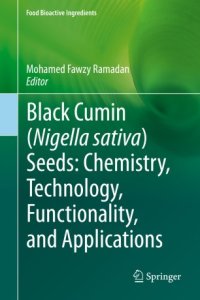
Ebook: Black cumin (Nigella sativa) seeds: Chemistry, Technology, Functionality, and Applications
Author: Mohamed Fawzy Ramadan
- Tags: Life Sciences, Plant Sciences, Plant Biochemistry, Organic Chemistry, Food Science, Pharmaceutical Sciences/Technology, Nutrition
- Series: Food Bioactive Ingredients
- Year: 2021
- Publisher: Springer International Publishing
- Edition: 1st ed.
- Language: English
- pdf
Recent developments in the field of nutrition have led to increased interest in herbs and medicinal plants as phytochemical-rich sources for functional food, nutraceuticals, and drugs. As research sheds light on the therapeutic potential of various bioactive phytochemicals, the demand for plant extracts and oils has increased.
Black cumin or black seeds (Nigella sativa) have particularly widespread nutritional and medicinal applications. In traditional medicine, black seeds are used to manage fatigue and chronic headache. Black seed oil is used as an antiseptic and analgesic remedy and for treatment of joint's pain and stiffness and can be mixed with sesame oil to treat dermatosis, abdominal disorders, cough, headache, fever, liver ailments, jaundice, sore eyes, and hemorrhoids. Thymoquinone, the main constituent in black seed volatile oil, has been shown to suppress carcinogenesis.
Black cumin (Nigella sativa) seeds: Chemistry, Technology, Functionality, and Applications presents in detail the chemical composition, therapeutic properties, and functionality of high-value oils, phytochemicals, nutrients, and volatiles of the Nigella sativa seed. Organized by formulation (seeds, fixed oil, essential oil, and extracts), chapters break this seed down into its chemical constituents and explore their role in the development of pharmaceuticals, nutraceuticals, novel food, natural drugs, and feed. Following numerous reports on the health-promoting activities of Nigella sativa, this is the first comprehensive presentation of the functional, nutritional, and pharmacological traits of Nigella sativa seeds and seed oil constituents.








